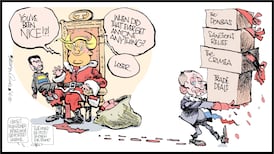In August, a LucidTalk opinion poll showed 69 per cent of nationalist voters in Northern Ireland agreed with a statement by Michelle O’Neill, the Sinn Féin vice-president, that “there was no alternative to violent resistance to British rule during the Troubles”.
This was a reversal of voting patterns throughout the Troubles. In 1998, the year of the Belfast Agreement, 70 per cent of Catholic respondents to the Northern Ireland Life and Times Survey said they had “no sympathy at all” with the reasons republicans gave for violence. Peace and powersharing were hardly expected to turn this on its head. But while there was dismay at August’s finding, there should not have been much surprise.
Sinn Féin has been the largest nationalist party in the North for a generation, following a landmark assembly election in 2003. Voters have switched to it for representation in the present, not to justify the past. Once they make the switch, however, people naturally begin to subsume and identify with Sinn Fein’s version of history.
[ Fintan O’Toole: The full, unexpurgated version of Up the ’RaOpens in new window ]
The party would have to actively disown the IRA to prevent this happening, which it is not about to do, certainly of its own volition. The peace process assumption Sinn Féin would have to reject past violence to grow has turned out to be precisely wrong: as Sinn Féin grows, past violence is retrospectively endorsed.
READ MORE
Now the same thing is happening in the Republic. In the 2020 general election, another landmark for Sinn Féin, the overriding concern for the party’s voters was housing, cited by 38 per cent in The Irish Times/Ipsos MRBI exit poll. Health and pensions were next, on 28 and 10 per cent. In fact, socio-economic issues were the only concerns cited.
So few Sinn Féin voters mentioned a united Ireland or a border poll that both issues registered at zero, despite their high profile during the party’s campaign. Brexit also registered at zero, although Fine Gael called the election to capitalise on Brexit-related nationalist sentiment.
[ Miriam Lord: Taoiseach stands corrected on Sinn Féin with a feat of fast talkingOpens in new window ]
Here was another idealised peace process moment, widely seen as such at the time, when Sinn Féin could have moved beyond the past to what are quaintly known in the north as “real issues”.
Instead, two years later, has come an outpouring of “cultural republicanism”’, as Una Mullally described it on these pages last week. Sinn Féin did not have to do anything to make this happen, apart from not actively trying to stop it.
Could this be a moment when the party revises its Troubles narrative and explores meaningful reconciliation, or at least takes that posture as a signal to the Republic?
There are cross-Border differences, of course. Cultural republicanism could be a wider yet shallower phenomenon than its northern counterpart. Northern Ireland is a divided society: even people with no memory of the Troubles are careful and indeed considerate of each other. There are few such constraints in the Republic.
In the North, any allusion to the IRA is almost always seen as referring to the Provisional IRA. In the South, it is conflated with Irish independence, or distinguished from it, or mixed up between the two. Muddying these waters is one active step Sinn Féin has taken to excuse the IRA. The party is clearly trying to legitimise a single thread of history, running from the Easter Rising through the Troubles and the Belfast Agreement to a united Ireland, delivered by itself.
Events at Stormont could point to how aggressively this will be pursued. Sinn Féin is about to lead a coalition, albeit as the first among equals in a mere devolved executive. Mrs O’Neill wants to be “a First Minister for all”. Could this be a moment when the party revises its Troubles narrative and explores meaningful reconciliation, or at least takes that posture as a signal to the Republic? We await the end of the DUP’s Stormont boycott to find out.
Alternatively, change could be forced in the Republic. Reporting in advance of Fianna Fáil’s annual conference two weeks ago, The Irish Times revealed the party’s probable conditions for coalition with Sinn Fein: “unambiguously repudiating the IRA”, “a complete apology for the violence of the Troubles”, “recognition of the role of the Garda, Defence Forces and the courts, including the Special Criminal Court” and “rhetorically concede that there are two jurisdictions on the island, called Ireland and Northern Ireland.”
Trying to achieve this would amount to a southern peace process, something that with hindsight should have been included in the Belfast Agreement. Like any negotiation, both sides would have to compromise.
Fianna Fáil would be attempting a republican synthesis with Sinn Féin. Fine Gael is plainly considering a different approach, where enough constitutional differences would be left to distinguish it from Sinn Féin in coalition. Leo Varadkar’s speech at this month’s Ireland’s Future conference suggests he might see his party and Sinn Féin offering a light green versus dark green stance on Irish unity.
The Tánaiste should ask the SDLP how that plan last worked out.












